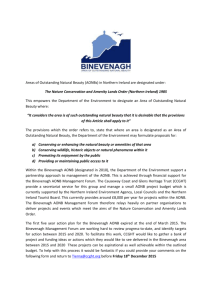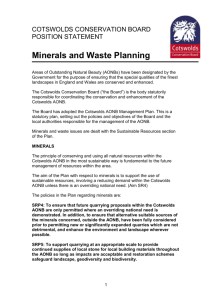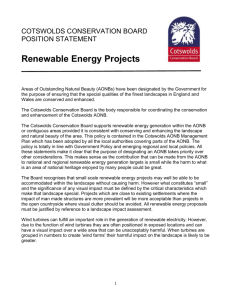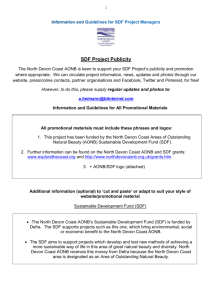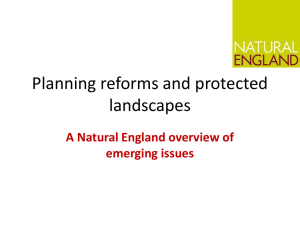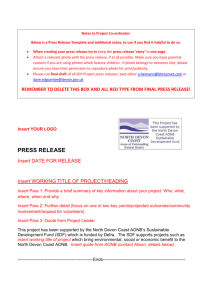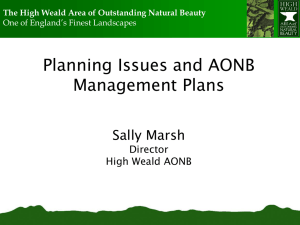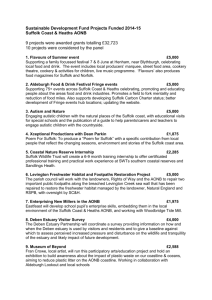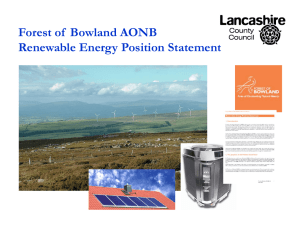Protocol between Natural England Cheshire to Lancashire Area
advertisement
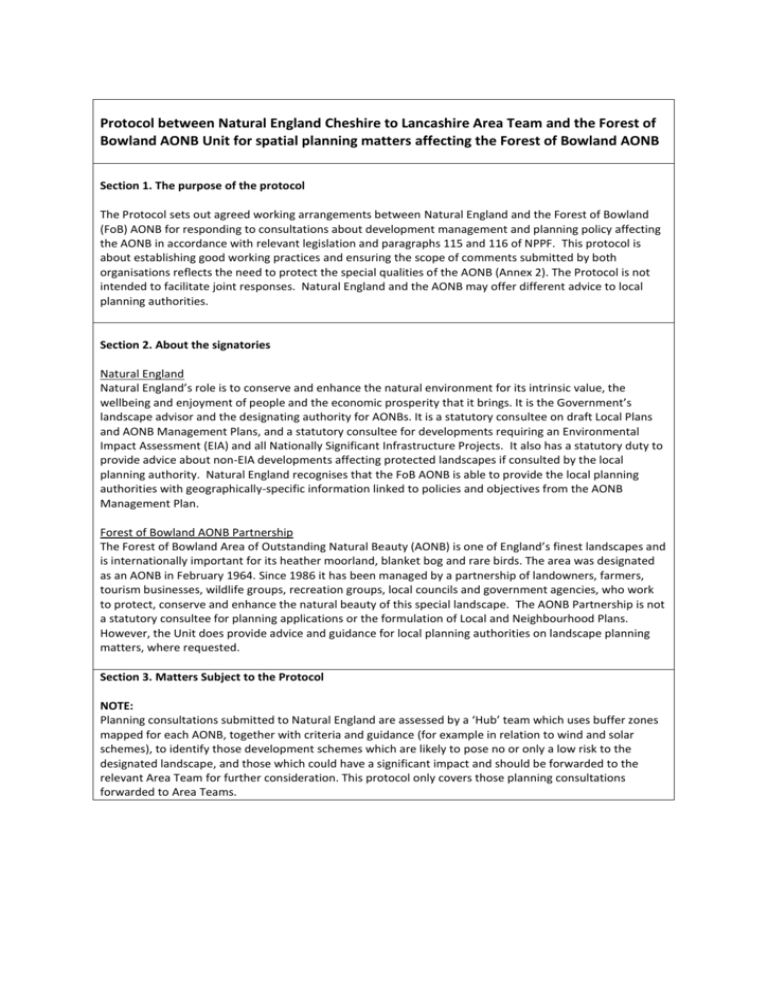
Protocol between Natural England Cheshire to Lancashire Area Team and the Forest of Bowland AONB Unit for spatial planning matters affecting the Forest of Bowland AONB Section 1. The purpose of the protocol The Protocol sets out agreed working arrangements between Natural England and the Forest of Bowland (FoB) AONB for responding to consultations about development management and planning policy affecting the AONB in accordance with relevant legislation and paragraphs 115 and 116 of NPPF. This protocol is about establishing good working practices and ensuring the scope of comments submitted by both organisations reflects the need to protect the special qualities of the AONB (Annex 2). The Protocol is not intended to facilitate joint responses. Natural England and the AONB may offer different advice to local planning authorities. Section 2. About the signatories Natural England Natural England’s role is to conserve and enhance the natural environment for its intrinsic value, the wellbeing and enjoyment of people and the economic prosperity that it brings. It is the Government’s landscape advisor and the designating authority for AONBs. It is a statutory consultee on draft Local Plans and AONB Management Plans, and a statutory consultee for developments requiring an Environmental Impact Assessment (EIA) and all Nationally Significant Infrastructure Projects. It also has a statutory duty to provide advice about non-EIA developments affecting protected landscapes if consulted by the local planning authority. Natural England recognises that the FoB AONB is able to provide the local planning authorities with geographically-specific information linked to policies and objectives from the AONB Management Plan. Forest of Bowland AONB Partnership The Forest of Bowland Area of Outstanding Natural Beauty (AONB) is one of England’s finest landscapes and is internationally important for its heather moorland, blanket bog and rare birds. The area was designated as an AONB in February 1964. Since 1986 it has been managed by a partnership of landowners, farmers, tourism businesses, wildlife groups, recreation groups, local councils and government agencies, who work to protect, conserve and enhance the natural beauty of this special landscape. The AONB Partnership is not a statutory consultee for planning applications or the formulation of Local and Neighbourhood Plans. However, the Unit does provide advice and guidance for local planning authorities on landscape planning matters, where requested. Section 3. Matters Subject to the Protocol NOTE: Planning consultations submitted to Natural England are assessed by a ‘Hub’ team which uses buffer zones mapped for each AONB, together with criteria and guidance (for example in relation to wind and solar schemes), to identify those development schemes which are likely to pose no or only a low risk to the designated landscape, and those which could have a significant impact and should be forwarded to the relevant Area Team for further consideration. This protocol only covers those planning consultations forwarded to Area Teams. Development Plan Documents (statutory) Local/Neighbourhood Plans (and other types of Development Plan Document e.g. Core Strategies, Allocations Plan) Natural England is a statutory consultee on Local Plans and Neighbourhood Plans. The Area Team will be consulted on all draft local plans and prioritise engagement according to environmental risk and opportunity. Where the local plan area encompasses part of the AONB or its setting, we will consider how the policies and proposals relate to the protected landscape. The AONB Partnership is not a statutory consultee for the formulation of Local and Neighbourhood Plans. However, the Unit does provide advice and guidance for local communities and planning authorities on landscape planning matters, where requested. Where either Natural England or the AONB Unit consider that a draft local plan or neighbourhood plan may affect the AONB or its setting we will: advise each other if we intend making a substantive response to a consultation. discuss or exchange draft copies of substantive comments to check for differences of opinion or emphasis, and seek to resolve any significant differences where possible. if Natural England’s Area Team does not intend to make a substantive comment, we may nevertheless advise the planning authority to consult the AONB Unit. However, we will agree this before doing so. Supplementary Planning Documents (non-statutory) SPDs are non-statutory - they may cover topics such as renewable energy or built design. They inform the preparation of Local Plans and the determining of planning applications. Where SPDs are proposed that are particularly relevant to the purpose of AONB designation, Natural England and/or the AONB Unit may decide, on the basis of environmental risk or opportunity, to work with local planning authorities to help them prepare planning related guidance which seeks to uphold the purpose of the AONB designation. In such cases, we will advise each other of our intentions. The AONB Partnership published an AONB Renewable Energy Position Statement in April 2011 (with various revisions since). The statement sets out the Forest of Bowland AONB Joint Advisory Committee's position with regard to the impacts of siting renewable energy developments, both within and adjacent to the boundaries of the Forest of Bowland AONB. This guidance is intended to assist in the determination of planning applications submitted to the planning departments of local authorities in the AONB partnership. Development Management consultations Natural England is normally consulted on all development that is likely to have an impact on the AONB. We are a statutory consultee for EIA developments and NSIPs. The AONB Unit is normally consulted by local planning authorities on development proposals that may impact on the AONB landscape. In practice we will: liaise on significant and major planning applications affecting the AONB or its setting* that each is consulted on or aware of. notify each other in advance of an intention to submit a consultation response, and provide details of the scope of the intended response ensure that local issues identified by the AONB are available for consideration by Natural England’s Area Team in determining its response share environmental and other evidence that forms the basis of planning consultation responses made by the AONB and Natural England’s Area Team if Natural England’s Area Team does not intend to make a substantive comment, we may nevertheless advise the planning authority to consult the AONB Unit. However, we will agree this before doing so. exchange draft comments before the consultation deadline to check for differences of opinion or emphasis and seek to resolve any conflicts if possible if Natural England knows that a development does not raise any concerns for the AONB Partnership or Board it will usually issue a ‘no objection’ response. if Natural England intends to object to a scheme it will liaise with the AONB Partnership or Board and a Natural England officer or an appointed agent (landscape consultant) will undertake a site visit. liaise on any action they propose to take in relation to an appeal *Those developments potentially giving rise to significant adverse effects on the natural beauty of the AONB landscape and therefore in conflict with the purpose of designation. As a minimum threshold for determining significant/major, we will use the definition of “major development” provided by the Town & Country Planning (Development Management Procedure) England 2010. Particular types of development potentially giving rise to significant impacts on the AONB Wind energy development Other vertical structures (e.g. mobile masts, pylons) Seeking opportunities for environmental gains consistent with the conservation of the AONB’s natural beauty Natural England and the AONB Unit will, through the planning system, seek opportunities to enhance the natural beauty of the AONB and peoples’ understanding of the designated area. This could include: working closely together on responses to development proposals that involve biodiversity offsetting organising training and awareness events for local planning authority staff aimed at raising awareness and understanding of the importance of protecting and enhancing the AONB through the planning system, including their obligations under S85 of the Countryside and Rights of Way Act 2000. Section 4. How we will work Principal contacts The principal contact for the AONB Unit will be Elliott Lorimer, Principal AONB Officer, Kettledrum, 6 Root Hill Estate Yard, Whitewell Rd, Dunsop Bridge, Clitheroe, BB7 3AY. Tel: 01200 448000 or 07775 221208. Email: elliott.lorimer@lancashire.gov.uk The principal contact for Natural England will be Roy Hymas, Second Floor, Arndale House, the Arndale Centre, Manchester, M4 3AQ. Tel: 07900 608291. Email: roy.hymas@naturalengland.org.uk Section 5. Reviewing the protocol and the effectiveness of working arrangements The Protocol will be reviewed at a joint meeting of the principal contacts each February/March. We will use up to 3 case studies to determine its effectiveness and the need for any changes to be made. Signatures I agree to the terms of the Protocol outlined above: Signature: ……………………………………………… Name: ……………………………………. Signed on behalf of the ( ) AONB Position: Date: …………………… I agree to the terms of the Protocol outlined above: Signature: ……………………………………………… Name: ……………………………………. Signed on behalf of Natural England Position: Date: …………………… Annex 1 - Relevant statutory duties, national planning policy and other government policies Planning and development in AONBs The fundamental principle underlying planning and development management in AONBs is that any new development within the AONB that has a materially adverse impact can only proceed where it is demonstrated that it satisfies an over-riding national need. All development is expected to conform to a very high standard of design, to be in keeping with local distinctiveness and should seek to conserve and enhance the AONB’s natural beauty. Within Section 85 of the CRoW Act (2000) there is a duty on all relevant authorities to have regard to this purpose in exercising or performing any functions in relation to, or so as to affect land in, AONBs. Sections 88 & 89 of the Act state that each local authority and Conservation Board shall prepare and publish a Management Plan for their AONB, which should then be reviewed at intervals of no more than 5 years. Management Plans are adopted statutory policy of the local authority. The Government has confirmed that the landscape qualities of National Parks and AONBs are equivalent, so the protection given by the land use planning system to natural beauty in both types of area should also be equivalent. The AONB designation is also of international importance, recognised as a Category V Protected Landscape by the International Union for the Conservation of Nature (IUCN). A local planning authority has a duty to have regard to the conservation and enhancement of natural beauty. This is achieved through partnership with AONBs and by reference to their Management Plans as a material consideration. The AONB Partnership (and Unit) is not a statutory consultee for planning applications or the formulation of Local and Neighbourhood Plans. However, the Unit does provide advice and guidance for local planning authorities on landscape planning matters, where requested. Natural England is the statutory consultee for landscape-related planning issues (alongside its broader land use planning remit for protection and conservation of the natural environment). The AONB Unit liaises with Natural England's Land Use Planning team on these and other related matters. National Planning Policy Framework (NPPF) The Government's NPPF provides specific planning guidance for development planning and decision-making in relation to AONBs. It confirms that great weight should be given to conserving landscape and scenic beauty, and that AONBs have the highest status of protection in relation to landscape and scenic beauty. AONBs and their management plans are material considerations in planning. The ‘great weight test’ is significant and it is one of the most stringent legal tests that can be applied under planning law. In specific relation to major development 1, the NPPF states that planning permission should be refused for major developments in AONBs except in exceptional circumstances and where it can be demonstrated they are in the public interest. 1The Town and Country Planning (Development Management Procedure) (England) Order 2010 Annex 2 – AONB Special Qualities Why is the AONB Special? Natural beauty is at the heart of what makes the Forest of Bowland AONB special: it is the reason why the Bowland landscape is designated of national and international importance; and of course, it’s also a key factor in attracting visitors. This natural beauty is derived from the area’s unspoilt countryside (i.e. a lack of largescale or intrusive development) combined with a number of other distinctive qualities that contribute to the area’s unique character or ‘sense of place’. The distinctive qualities of the Forest of Bowland AONB are numerous and varied, though in general terms they can be summarised using the following headings: - Wild Open Spaces A Special Place for Wildlife A Landscape Rich in Heritage A Living Landscape Delicious Local Food and Drink A Place to Enjoy and Keep Special These headings were developed as part of work undertaken in 2005 to identify and explore the AONB’s ‘sense of place’ - that being the area’s unique feel and appearance, or what constitutes the area’s identity and makes it different from neighbouring areas. The headings are not intended to be exclusive or exhaustive - rather, they provide a framework by which the distinctive qualities of the AONB can be understood and communicated among relevant stakeholders, including visitors. More information on the special qualities of the AONB is available on www.forestofbowland.com
